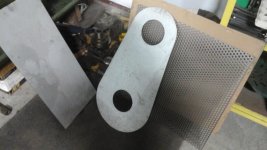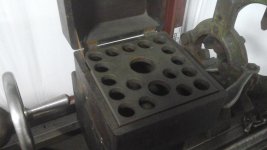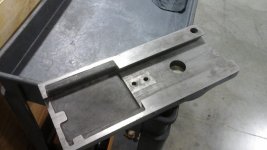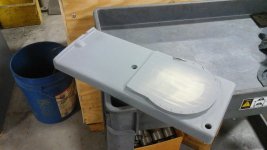I Got a really good start cutting down the saddle last night. I took .020 off the tops of the dovetails, and .045 off of the cross-slide ways. I used a fly cutter with a narrow 1/16" radius cutter (hand ground lathe grooving tool), that didn't leave the smoothest finish, but was able to reach in and under-cut the dovetails with a nice 1/8" round channel. I was able to get those 4 surfaces done in a single set-up clamped down on 3 ground blocks. Not very rigid out on the wings, but the ways cut well. I did some material removal on the 2 wings furthest from the chuck, but I'm going to need to re-clamp the work to get the other side, and I'm going to switch to a better cutter now that the dovetail is out of the way.
I still need to get my wear material ordered. I'm quoting Rulon from Bedecker Plastics in Shiner Texas (USED to be our back-yard till we moved). I quoted bigger pieces to have some on the shelf, but that stuff sure is expensive! The minimum I'd need for the crosslide would be around 4"x24".
.062"x12"x24" = $152.45 (won't work for this job)
.125"x12"x24" = $460.00

Granted that's a couple projects worth and it's only a small fraction of the cost of a rebuild. I just need to get it ordered. If I just order a .125"x4"x24" piece, that's around $150.
I'm also ordering some 1/8" bronze to use for the 2nd cross-slide gib. Comparatively it's a lot cheaper than Rulon (1/8"x4"x24" = $66.74), so I don't want to be a Harry-Home-Shop, but I'm considering using it under the cross-slide instead. I can also get a full sheet of Garolite phenolic (the "good" stuff that's made for ways. Wear resistant and graphite impregnated), 1/8"x18"x39" = $50.36.
My understanding is that they used to use Phenolics for way pads alot more often before Rulon/Turcite/Teflon came around, and that the plastics are much better, but the Phenolics did work. At this point, I want to get all 3 materials in hand to "play" with, but I'll use the Rulon. I'm also waiting to hear back from Devitt on a Moglice quote.
NOW, when it comes time to get the bed plained and build up the bottom of the saddle... that's going to take some work. I'm estimating I'll need 3/16" to adhere to the bottom of the saddle. That much Rulon might be out of the budget, but Moglice, Bronze, or Garolite might be doable.
 .
. .
.









 lol, yep that's around the corner, but that's also one reason why I haven't finished the wiring yet.
lol, yep that's around the corner, but that's also one reason why I haven't finished the wiring yet.











